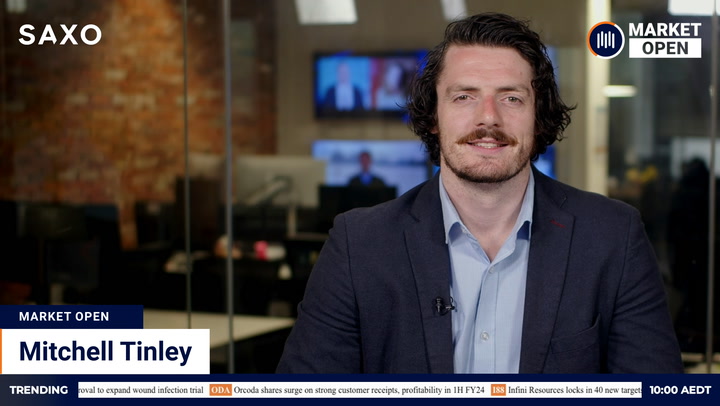A risk-off session on Wall Street points to early pressure on Australian stocks amid fears rising interest rates will slow the global economy.
ASX futures declined 22 points or 0.29 per cent after the Nasdaq Composite slumped almost 2.2 per cent. The Dow and S&P 500 shed more than 1 per cent, with losses accelerating into the close.
Oil fell below US$100 a barrel for the first time in almost a month. Iron ore and industrial metals also declined. Gold rose for a third day. The dollar retreated towards 74 US cents.
Wall Street
US stocks fell as treasury yields hit a three-year high, a headwind for stocks whose valuations depend more on their future profit outlooks than current earnings.
The Nasdaq Composite led the selling with a loss of 299 points or 2.18 per cent. The S&P 500 dropped 76 points or 1.69 per cent. The Dow Jones Industrial Average gave up 413 points or 1.19 per cent.
“There’s been two kinds of sell-offs in the past month or two,” Peter Tuz, president of Chase Investment Counsel, told Reuters.
“There’s the rising yields which primarily affects tech and other growth stocks, and then there’s the recession/economic slowdown sell-off that affects energy and various materials’ names. Today you’re seeing both.”
A key US interest rate, the yield on ten-year US treasuries, climbed to its highest since January 2019 as bond markets sold off for a seventh straight night. (Yields move inversely to prices.)
The rally in yields came ahead of tonight’s March inflation report, which is expected to confirm rising pricing pressures on consumers after the Federal Reserve delayed raising rates in the belief rising inflation would prove “transitory”. Analysts predict the report will show the hottest year-on-year growth since 1981, forcing the Fed to raise rates sharply this year.
Rate-sensitive tech and growth stocks have led the selling since comments from a leading Fed official last week confirmed the likely pace of monetary tightening this year. The Nasdaq Composite has fallen more than 5 per cent this month, erasing the March rebound and extending its decline from its high beyond 17 per cent.
Overnight, Nvidia fell 5.2 per cent, Tesla 4.83 per cent, Microsoft 3.94 per cent and Apple 2.55 per cent.
Energy stocks stumbled as the global oil benchmark settled below US$100 a barrel. Brent crude declined US$4.30 or 4.2 per cent to US$98.48 a barrel. The US benchmark fell 4 per cent to US$94.29.
Oil has fallen from a multi-year high as China’s Covid lockdowns undercut demand at a time when the US and other countries are increasing supply by releasing strategic reserves.
Occidental Petroleum lost 6.28 per cent, Diamondback Energy 4.85 per cent and Chevron 2.57 per cent.
Airlines rallied as the fall in fuel prices reduced a major cost. The S&P 500 Airlines Industry Index gained 2.81 per cent.
Australian outlook
The ASX has so far weathered a week-long Wall Street sell-off with minimal damage. Futures action suggests optimism the domestic market will continue to outperform, cushioned by milder inflation and a slower rates trajectory. The loss predicted by this morning’s SPI200 reading looks minor compared to the bloodletting in the US.
The S&P/ASX 200 eked out a slim win of seven points yesterday as banks and supermarkets ground higher.
“The ASX 200 scraped a 0.1% gain after handing back nearly all its earlier gains yesterday,” City Index senior market analyst Matt Simpson said. “Whilst 65% of its stocks advanced, 5 of its 11 sectors declined which underscores what a mixed bag it was overall. Yet its 1-day reversal pattern, close beneath 7500 and weak lead from Wall Street warns of the potential for weakness today.
“Looking over the past week it been a defensive play with the consumer staples sector closing at a year-to-day high, and utilities rising to its highest level since August 2020. Meanwhile, the tech sector touched a 3-week intraday low yesterday and consumer discretionary technology hit a 1-month low.
“Until we see these patterns reverse it seems likely the ASX 200 will remain in a choppy phase with the potential for a deeper pullback before its trend resumes.”
The US financial and consumer staple sectors were among the better performers overnight, but all 11 US sectors ended firmly lower.
The energy sector bore the brunt of the sell-off, shedding 3.11 per cent after Brent crude broke a key psychological support level. Tech was next weakest with a loss of 2.6 per cent.
Havens were scarce. Airlines were a rare pocket of strength. The NYSE Arca Gold Bugs Index fell 0.43 per cent even as gold rose for a third session. Other traditional havens such as healthcare and utilities lost at least 1.4 per cent.
Industrials was the pick of a rotten bunch with a loss of 0.29 per cent. Materials lost 0.45 per cent and financials 0.48 per cent.
On today’s domestic economic calendar, measures of weekly consumer confidence and monthly business confidence were due this morning. Lynas Rare Earths was scheduled to release earnings.
The dollar continued to retreat from last week’s ten-month high, falling 0.35 per cent to 74.19 US cents.
Commodities
Commodity prices were pressured by a rising US dollar and weakening demand amid Covid restrictions in the world’s second-largest economy. Iron ore and industrial metals continued to pare gains since Russia invaded Ukraine.
The spot price for ore landed in northern China dropped US$2.32 or 1.5 per cent to US$153.18 a tonne.
Benchmark aluminium on the London Metal Exchange plunged 4 per cent to US$3,218.25 a tonne. Copper declined 1.2 per cent, nickel 4.1 per cent, lead 0.3 per cent and tin 0.7 per cent. Zinc gained 0.5 per cent
“A stronger dollar and resurgence of COVID-19 in China are major headwinds for the industrial metals right now,” Jigar Trivedi, commodities analyst at broker Anand Rathi Shares, told Reuters.
“However, looking at the LME warehouse inventories, the demand is at pre-COVID levels and energy cost is higher owing to Russia-Ukraine crisis. The outlook for new age materials, like battery metals aluminium, zinc and copper is bullish.”
BHP and Rio Tinto fell in overseas action. BHP‘s US-traded depositary receipts declined 2.28 per cent. The Big Australian’s UK stock lost 3.13 per cent. Rio Tinto gave up 0.67 per cent in the US and 1.11 per cent in the UK.
Gold inched higher for a third session as investors bought havens against inflation. Metal for June delivery settled US$2.60 or 0.1 per cent ahead at US$1,948.20 an ounce.





